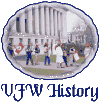![]()

 For an organization to remain progressive, it must continually change with the
times. It must constantly assess the needs and problems of its members and adjust its
goals to address those problems. In the first fifteen years after the VFW's founding, its
members did not lack for goals. But as yet, its members did not have the experience or
knowledge that would enable them to successfully achieve all their goals. For an organization to remain progressive, it must continually change with the
times. It must constantly assess the needs and problems of its members and adjust its
goals to address those problems. In the first fifteen years after the VFW's founding, its
members did not lack for goals. But as yet, its members did not have the experience or
knowledge that would enable them to successfully achieve all their goals.During this period, the VFW's goals focused primarily on the needs of two important groups - present-day veterans and their families, and servicemen who would be the nation's future veterans. For the benefit of the first group, the VFW advocated for veterans' entitlements such as job preference, vocational rehabilitation and training, pensions for disabled veterans and families of deceased veterans, and medical care for veterans with service-connected disabilities. For the benefit of the second group, the VFW worked for reforms in military preparedness to ensure that our armed forces would never again be sent into combat as poorly trained and equipped as were the troops of the Spanish American War. No organization had ever before dared to challenge the government's stance on recruiting, training, and equipping its servicemen. And although the VFW's early cries on the subject of preparedness were largely ignored, the VFW never relinquished its goal. Eventually the VFW would make up for what it lacked in experience with stamina and determination. During these learning years, many of the victories the VFW won were small. Many of its attempts to secure what it deemed fair treatment for the nation's veterans failed. Yet in each attempt, there was a victory. The victory was learning that the VFW could influence legislation on behalf of its veterans. Thomas Crago, United States Congressman from Pennsylvania, was elected VFW Commander-in-Chief in 1914, and was responsible for what is recognized as the greatest VFW victory of that time; the pension bill which provided for the widows of Spanish War Veterans, which he authored and defended on the floor of the House. Through Crago and others like him, the organization learned how and when to apply its influence to gain the legislation necessary to accomplish its goals. In the near future, these hard-learned lessons would serve well both the VFW and a much larger group of veterans. In 1915, the nation's need to prepare for war was palpable to the VFW. True, President Woodrow Wilson had vowed to keep the United States out of war, but all over the world, events appeared to be drawing the United States inexorable closer to war. As if the members of the VFW needed any further evidence that a war was on the horizon, President Wilson issued a call for men to serve on the Mexican border. Because many VFW members responded, quite a few familiar faces were missing from the National Encampment in 1915. From the moment the National Encampment was gaveled to order in Detroit on August 16, much of the talk centered on the need for preparedness. According to the Detroit News Tribune, one of the first practical suggestions was offered by W.S. Voorsanger, a member from Pittsburgh. Voorsanger proposed a plan to create an "adequate veteran reserve" by "securing the enlistment in such reserve of several hundred thousand veterans of the campaigns of the last two decades." Although this suggestion was never adopted on a national level, many departments supplied their states with men who performed some of the duties a reserve corps might have provided. These men patrolled sea coasts and national boundaries and investigated and reported suspected subversive groups and saboteurs. On April 6, 1917, at President Wilson's urging, Congress declared war on Germany. Over the next eighteen months, the VFW would prove many times over that it had meant what it said when it promised President Wilson "the united support of the members of this organization, in any crisis that may arise." America's declaration of war galvanized the VFW into action. More than 60 percent of its members decided to make the supreme contribution to their country's war efforts by going back into uniform. Those still at home channeled their efforts into four main areas: helping to win the war, fighting for entitlements for the veterans-to-be, advocating for the needs of servicemen's families, and recruiting new members. Perhaps the VFW's most valuable assistance toward winning the war was in recruiting. Besides helping to register men for the draft, VFW posts helped with recruitment in other ways. Putting into action an idea first proposed at the 1915 National Encampment, the posts in Allegheny County, Pennsylvania, organized a Veteran Reserve Corps to take over when the National Guard of that state was ordered overseas. To keep up the morale of the servicemen they had helped to recruit, many posts inaugurated a special "Vets to Vets" letter program. Through this program, posts tried to target men from their hometown who didn't receive mail from home. One last "direct support" service the VFW offered the armed forces during the war was to help the military overcome its shortcomings in equipment. Despite the VFW's continuous pleading with the federal government in past years for the maintenance of an up-to-date and well-equipped military organization, its advice had mostly fallen on deaf ears. As a result, the armed forces were thrust into another war almost as ill equipped as they had been during the Spanish American War. In 1917, the entire VFW National Encampment got into the act of raising money for much-needed equipment. The delegates and others attending the meetings sold pencils on the streets of New York City - the host city - in one of the nation's earliest street-sales fund-raisers. With the proceeds, the VFW purchased two ambulances for donation to the U.S. Army. At the same time the members of the VFW were throwing themselves into the war effort, they were also looking ahead to the day when the troops now fighting the "War to End War" would be veterans. The veterans of 1898 knew from personal experience of the "war's over" apathy of the public; they knew they could not wait until the boys came home to secure for them the entitlements they had earned. Armed with this knowledge, they constantly reminded the government and politicians of their promises. On a national level, the VFW worked to secure some form of insurance against disability or loss of life for service members. On September 2, 1915, Congress had approved an act which covered losses or damage suffered by our Merchant Marine or commercial companies due to actions of warring European nations. This War Risk Insurance Act, however, did not extend to members of the armed forces or to naval ships and their cargo. Finally, after years of prodding from the VFW, the government expanded the act's coverage. Shortly after war was declared, Congress approved the new War Insurance Act, and in October 1917, an addition to it in the form of medical insurance for servicemen. This new system was pronounced by its originators to be "modern, scientific, complete and free from all deficits of the old Pension System." Unfortunately, the act's provisions were not handled expediently or efficiently. As a result, the act was amended eight times, then finally repealed in 1924. If the War Insurance Act was ultimately disappointing, another entitlement the VFW succeeded in winning was not. The enactment of Public Law 178 in 1918 marked the achievement of a major VFW objective. With this act, the federal government finally conceded the need for vocational training for disabled veterans who required special training for complete rehabilitation. Before this time, the returning disabled veteran had been discharged and made to fend for himself. Even if his previous employment had been as a stevedore or steeplejack, as far as the government was concerned, the loss of one or both legs was not a problem. Under Public Law 178, he would be trained at special centers to qualify for employment where his loss would present less of an obstacle. He would be reeducated to cope in a different environment and receive financial assistance for himself and his dependents. In June 1920, the VFW was finally awarded the Widows and Orphans Pension Bill which gave widows of veterans of the Spanish American War and the Philippine Insurrection $`12 a month plus an additional $2 for each child. While the VFW was working on behalf of veterans' families, many of these families were themselves taking an active role in veterans' affairs. At the organizational meeting in 1914, he VFW had approved the formation of a national Ladies Auxiliary. From the start of World War I, the VFW left no doubt that it seriously intended to become an organization for veterans of all wars, not just veterans of the Spanish American War. It worked to secure entitlements for all veterans, to obtain pensions for all veterans' families, and - most important to its future survival - to recruit veterans from all wars as members. One of the committees established to handle claims against the War Risk Insurance Act and Vocational Training Bureau evolved into a permanent Washington office known as the National Service Bureau. With the establishment of this bureau, the VFW became the first veteran's organization to maintain a permanent office in the nation's capital. As another result of its tremendous growth in membership, the VFW found it necessary to establish a level of leadership and authority midway between the national and local levels. At the 1920 Encampment in Washington, D.D., the delegates adopted a new set of bylaws that provided that all posts within each state be organized into a department. This department would be headed by a state commander elected by a delegate from those posts. The new arrangement would improve communication between the posts in each state and enable posts within a state to use their clout jointly when necessary. From its inception, the VFW had taken it for granted that veterans should, by law, be entitled to certain benefits. But the federal government did not officially acknowledge this self-evident truth until the 1920's. In that decade, the government took several actions that signaled it was finally ready to take veterans' entitlements seriously. First on August 9, 1921, the government transferred administration of veterans' entitlements from the Treasury Department to a separate Veterans Bureau. This move, made after several years of pleading from the VFW, meant that for the first time there were government officials whose job was to focus full time on veterans' problems. The second way the federal government officially recognized the needs of veterans was by forming Veterans Affairs Committees in both the House of Representatives and the Senate. |









 E-Mail
E-Mail